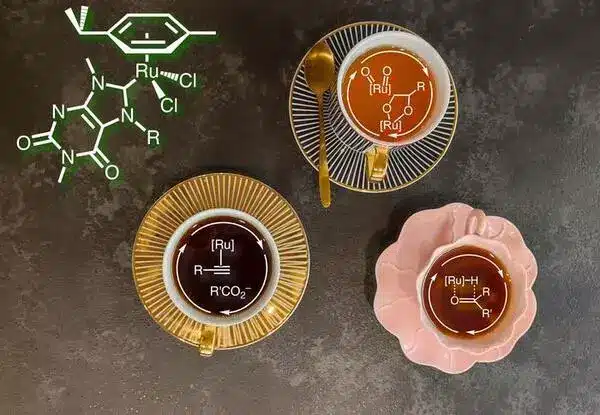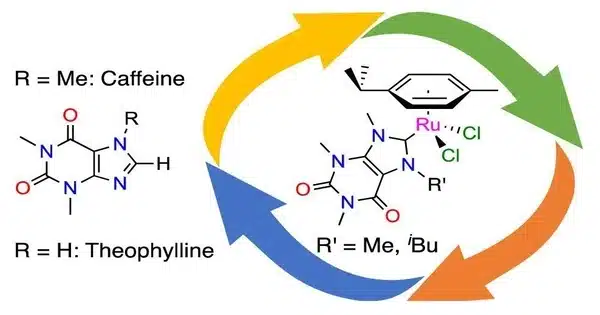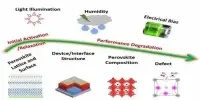Ruthenium is a transition metal that, due to its particular reactivity and stability, has shown significant promise as a catalyst in a variety of chemical processes. Its involvement in catalysis, including hydrogenation, oxidation, and C-C bond formation, has been intensively researched. Caffeine and theophylline are alkaloids found in plants such as coffee and tea that have similar structures. They have been researched for their possible biological activity and have medicinal applications.
Caffeine and theophylline, two natural chemicals, are being used by researchers to create extremely efficient biosourced catalysts.
A study by Lionel Delaude and François Mazars, researchers from the Laboratory of Catalysis at the University of Liège (Belgium), has shown that caffeine and theophylline can be used to ‘green’ catalysts based on ruthenium. This chemical element belongs to the transition metals. The results of this study have been published in the scientific journal Organometallics and will remainin open access for six months.
Caffeine and theophylline can be used to ‘green’ catalysts based on ruthenium. This chemical element belongs to the transition metals. This discovery contributes to developing more sustainable and environmentally friendly organometallic chemistry.
Lionel Delaude and François Mazars
Catalysts are widely used in chemical processes because they allow reactions to be carried out more quickly and selectively under softer experimental conditions. They are typically derived from nonrenewable raw materials, such as petrochemicals and metallurgy. In accordance with the twelve principles of “green chemistry,” scientists are currently attempting to reduce the carbon footprint of their operations as much as possible. In this context, researchers from the University of Liège’s Laboratory of Organometallic Chemistry and Homogeneous Catalysis created biobased catalysts derived from caffeine and theophylline, two naturally occurring xanthine compounds found in high concentrations in coffee beans, tea leaves, and cocoa beans.
The whole process of adding value to these compounds is environmentally friendly since their extraction and separation from renewable plant sources requires only water and supercritical CO2,” explains Lionel Delaude, professor of chemistry and director of the laboratory. What’s more, they are under-exploited and available at low cost.

Slight modifications to the chemical structure of xanthines can be used to synthesize N-heterocyclic carbene precursors, which form the basis of many catalysts in the 21st century.
The work of Lionel Delaude and his doctoral student François Mazars has shown that the combination of a para-cymene ligand derived from a-phellandrene (an essential oil found in many plants, including dill and eucalyptus) and an N-heterocyclic carbene ligand derived from caffeine or theophylline with ruthenium (a low-toxicity metal from the iron family) leads to the formation of highly effective catalysts for promoting three major types of organic reaction, namely, the transfer hydrogenation of unsaturated substrates with isopropanol, the oxidation of alkenes with sodium periodate, and the synthesis of vinyl esters from 1-hexyne and benzoic acid.
This discovery contributes to developing more sustainable and environmentally friendly organometallic chemistry. Moreover, it opens the door to other catalytic applications using caffeine and theophylline to generate bio sourced N-heterocyclic carbenes.















